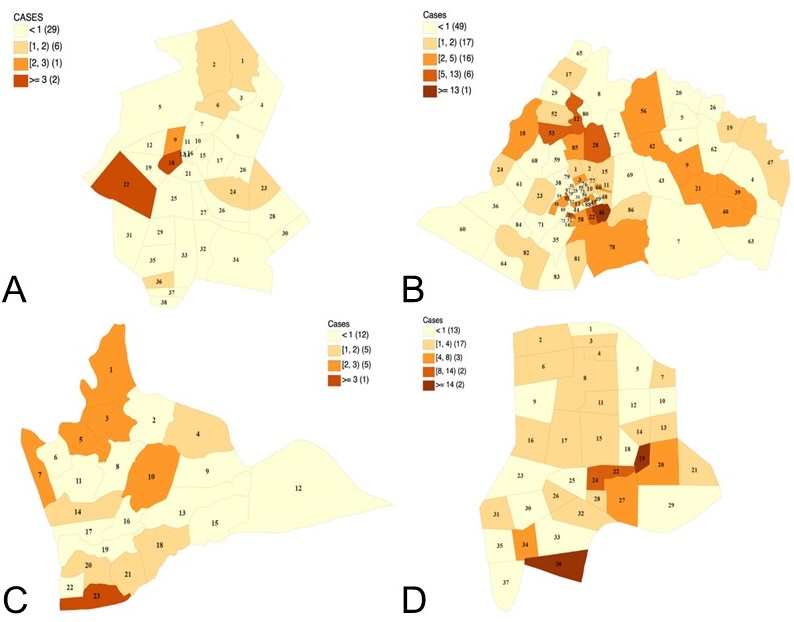Profiling of canine distemper virus infection from Small Animal Veterinary Clinics in Cities of Nueva Ecija, Philippines
Abstract
Canine distemper virus (CDV) is a highly contagious and lethal pathogen that affects domestic and wild mustelids. This retrospective study analyzed 267 CDV cases from veterinary clinics in Nueva Ecija of Philippines over three years (2020-2022). Data including age, sex, breed, vaccination status, and clinical signs were analyzed using the chi-square test. The highest infection rate (38.95%) was observed in dogs aged ≥ 13 months. Females showed higher clinical signs (53.18%) than males (43.82%). Toy breeds were the most affected (38.58%), and 68.54% of the cases were unvaccinated. Nasal discharge was the most common symptom (46.44%). The incidence of CDV peaked during the rainy season, with Cabanatuan City reporting the highest number of cases. A significant association was observed between age (p=0.003), breed (p=0.042), and CDV infection.
Downloads
References
Curi NH, Massara RL, de Oliveira Paschoal AM, Soriano-Araújo A, Lobato ZI, Demétrio GR, Chiarello AG, Passamani M. 2016. Prevalence and risk factors for viral exposure in rural dogs around protect-ed areas of the Atlantic Forest. BMC veterinary research.12:1-10. https://doi.org/10.1186/s12917-016-0646-3 | PMid:26822375 PMCid:PMC4730773
Latha D, Srinivasan SR, Thirunavukkarasu PS, Gunaselan L, Ramadass P, Narayanan RB. 2007. Assessment of canine distemper virus infection in vaccinated and unvaccinated dogs. Indian Journal of Biotechnology, 6(1):35-40.
Fitzgerald SD, Melotti JR, Cooley TM, Wise AG, Maes RK, O'Brien DJ. 2022. Geographic spread of canine distemper in wild carnivores in Michigan, USA: pathology and epidemiology, 2008-18. The Journal of Wildlife Diseases. 58(3):562-574. https://doi.org/10.7589/JWD-D-21-00184 | PMid:35675483
Gastelum-Leyva F, Pena-Jasso A, Alvarado-Vera M, Plascencia-López I, Patrón-Romero L, Loera-Castañeda V, Gándara-Mireles JA, Lar-es-Asseff I, Leal-Ávila MÁ, Alvelais-Palacios JA, Almeida-Pérez J. 2022. Evaluation of the Efficacy and Safety of Silver Nanoparticles in the Treatment of Non-Neurological and Neurological Distemper in Dogs: A Randomized Clinical Trial. Viruses. 14(11):2329. https://doi.org/10.3390/v14112329 | PMid:36366427 PMCid:PMC9694365
Hussein AK, Sullivan M, Penderis J. 2012. Effect of brachycephalic, mesaticephalic, and dolichocephalic head conformations on olfactory bulb angle and orientation in dogs as determined by use of in vivo magnetic resonance imaging. American journal of veterinary research. 73(7):946-951. https://doi.org/10.2460/ajvr.73.7.946 | PMid:22738044
Mahajan S, Dey S, Kumar A, Panigrahi P, Karunanithy M. 2018. Association and risk of canine distemper with respect to age, sex and breed of dogs suffering from demyelinating neuropathies. International Journal of Livestock Research. 8:164-171. https://doi.org/10.5455/ijlr.20170811080455
Martinez-Gutierrez M, Ruiz-Saenz J. 2016. Diversity of susceptible hosts in canine distemper virus infection: a systematic review and data synthesis. BMC veterinary research. 12:1-11. https://doi.org/10.1186/s12917-016-0702-z | PMid:27170307 PMCid:PMC4865023
Rahman DA, Saepuloh U, Santosa Y, Darusman HS, Pinondang IM, Kindangen AS, Pertiwi AP, Sari L, Irawan A, Sultan K, Rianti P. 2022. Molecular diagnosis with the corresponding clinical symptoms of canine distemper virus infection in javan leopard (Panthera pardus ssp. melas). Heliyon. 8(11), e11341. https://doi.org/10.1016/j.heliyon.2022.e11341 | PMid:36353167 PMCid:PMC9638774
Rendon-Marin S, da Fontoura Budaszewski R, Canal CW, Ruiz-Saenz J. 2019. Tropism and molecular pathogenesis of canine distemper virus. Virology journal. 16:1-5. https://doi.org/10.1186/s12985-019-1136-6 | PMid:30845967 PMCid:PMC6407191
Rendon-Marin S, Martinez-Gutierrez M, Suarez JA, Ruiz-Saenz J. 2020. Canine Distemper virus (CDV) transit through the Americas: need to assess the impact of CDV infection on species conservation. Frontiers in Microbiology. 11:810. https://doi.org/10.3389/fmicb.2020.00810 | PMid:32508760 PMCid:PMC7253583
Wang R, Wang X, Zhai J, Zhang P, Irwin DM, Shen X, Chen W, Shen Y. 2022. A new canine distemper virus lineage identified from red pandas in China. Transboundary and Emerging Diseases. 69(4):e944-e952. https://doi.org/10.1111/tbed.14370
Woma TY, van Vuuren M, Bosman AM, Quan M, Oosthuizen M. 2010. Phylogenetic analysis of the haemagglutinin gene of current wild-type canine distemper viruses from South Africa: lineage Africa. Veterinary microbiology. 143(2-4):126-132. https://doi.org/10.1016/j.vetmic.2009.11.013 | PMid:20060661

Copyright (c) 2024 CC-BY-SA

This work is licensed under a Creative Commons Attribution-ShareAlike 4.0 International License.
Authors who publish with this journal agree to the following terms:
1. Authors retain copyright and grant the journal right of first publication with the work simultaneously licensed under a Creative Commons Attribution License that allows others to share the work with an acknowledgement of the work's authorship and initial publication in this journal.
2. Authors are able to enter into separate, additional contractual arrangements for the non-exclusive distribution of the journal's published version of the work (e.g., post it to an institutional repository or publish it in a book), with an acknowledgement of its initial publication in this journal.
3. Authors are permitted and encouraged to post their work online (e.g., in institutional repositories or on their website) prior to and during the submission process, as it can lead to productive exchanges, as well as earlier and greater citation of published work (See The Effect of Open Access).

.jpg)















